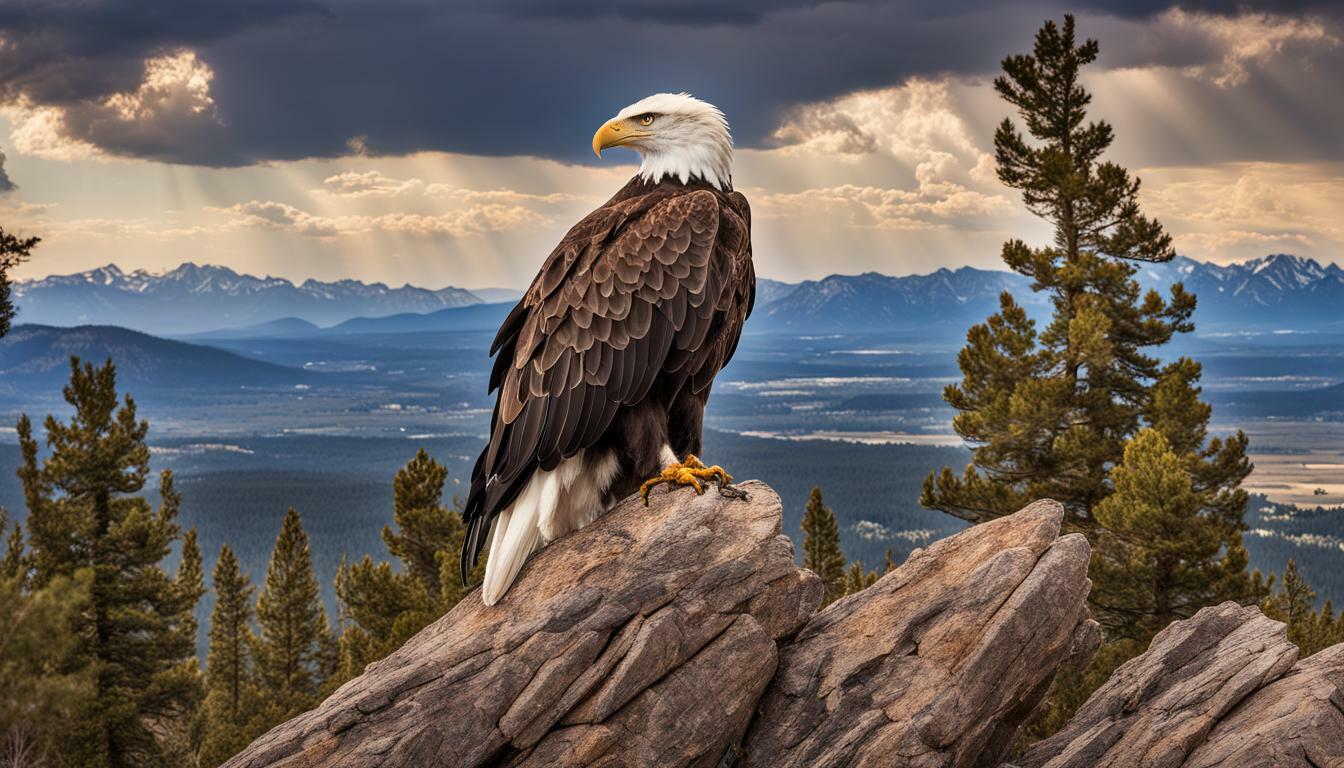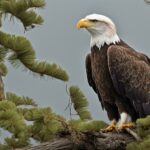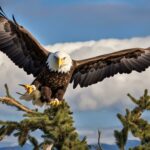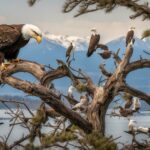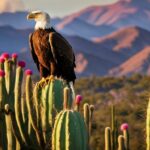Colorado’s natural beauty, diverse wildlife, and vast landscapes make it an ideal home for many species of birds, including the bald eagle. However, whether or not these majestic birds of prey are native to the Centennial State remains a topic of debate.
While bald eagles are an iconic symbol of American culture and heritage, their presence in Colorado has been a subject of study and conservation efforts for many decades. From their historical presence to their current status, this article will explore the truth about bald eagles in Colorado.
Key Takeaways:
- Whether or not bald eagles are native to Colorado is a topic of debate
- Bald eagles are an iconic symbol of American culture and heritage
- Colorado is an ideal home for many species of birds, including the bald eagle
The Bald Eagle: A Majestic Symbol of America
As you gaze up to the sky, catching a glimpse of a bald eagle is a truly breathtaking sight. These majestic creatures have been revered as a symbol of freedom, courage, and strength for centuries.
The bald eagle was officially adopted as the national bird and symbol of the United States in 1782, chosen for its representation of the country’s values. With a wingspan of up to 7 feet and a weight of around 14 pounds, the bald eagle is a formidable bird of prey, capable of diving at speeds of up to 100 miles per hour to catch its prey.
While bald eagles can be found across North America, their presence in certain regions has been impacted by habitat destruction, hunting, and pollution. In Colorado, the story of the bald eagle’s presence is a unique and fascinating one.
The Bald Eagle: A Majestic Symbol of America
“The eagle has been chosen as the embodiment of all the highest ideals of citizenship and its protection, and will guard us from national aggression from within and without. Thus was the American eagle raised from the obscurity of the almost extinct class of birds of prey, to be the emblem of our country.”
John F. Lacey, a U.S. Congressman who played a key role in passing the Bald Eagle Protection Act of 1918, penned these words in a 1916 congressional report. Since then, the bald eagle’s significance as a symbol of American values has only continued to grow.
From the seal of the President of the United States to the back of the one-dollar bill, the bald eagle is an enduring representation of freedom, democracy, and national pride.
Bald Eagles: Distribution and Migration Patterns
As you may know, bald eagles are large birds of prey that can be found throughout North America. They typically prefer to live near bodies of water that provide easy access to food, such as fish, waterfowl, and small mammals.
Their range extends from Alaska to northern Mexico, with populations also found in Florida and along the eastern seaboard. During the winter months, bald eagles may travel long distances in search of food, leading to sightings in areas outside of their regular range.
In Colorado, bald eagles can be found in a variety of habitats, including rivers, lakes, and reservoirs, as well as forested areas near these bodies of water. They tend to prefer areas that are isolated and undisturbed, and will often nest in tall trees near the water’s edge.
Despite their widespread distribution, bald eagles were once endangered due to habitat loss, pollution, and hunting. However, conservation efforts have helped to restore their populations, and the bald eagle was removed from the endangered species list in 2007.
Bald Eagles: Threats to Their Habitat
While bald eagles have made a remarkable recovery, their habitats continue to face threats from development, climate change, and pollution. In Colorado, efforts are underway to protect key areas and preserve the quality of their habitats.
The Colorado Division of Wildlife has identified several areas as critical habitat for bald eagles, including the upper Colorado River basin and the southeast region of the state. Conservation groups and government agencies are working together to monitor eagle populations and protect their nesting sites.
Bald Eagles: Migration Patterns
Like many bird species, bald eagles undertake impressive migrations each year in search of food and breeding grounds. In general, eagles breeding in northern regions tend to migrate south for the winter, while eagles breeding in southern regions may stay put year-round.
Some eagles have been known to travel as far as 3,000 miles during migration, with many following the major flyways along the eastern and western coasts. In Colorado, bald eagles can often be seen during the fall and winter months, when they may migrate to the state to take advantage of the abundant food sources.
Overall, bald eagles are a fascinating and important species that play a crucial role in the ecosystems where they live. While they faced significant challenges in the past, the efforts of scientists, conservationists, and government agencies have helped to bring them back from the brink and ensure their survival for generations to come.
Bald Eagles: Historical Presence in Colorado
Colorado is home to a diverse range of wildlife, but the presence of bald eagles was not always a certainty. The question of whether bald eagles are native to Colorado is a complex one, with a history that spans centuries.
Before European settlement, bald eagles were likely present in what is now Colorado, but their population was limited due to the state’s arid climate. In the early 1800s, fur traders and trappers began to explore the Rockies, and their presence had a significant impact on the region’s wildlife.
Bald eagles were hunted for their feathers, which were used in the fashion industry, and for their meat, which was considered a delicacy. By the early 20th century, the bald eagle population in Colorado had reached dangerously low levels, and the species was in danger of extinction in the state.
In the 1970s, bald eagles were listed as an endangered species under the Endangered Species Act. This protection, along with habitat restoration efforts and the banning of harmful pesticides, helped the bald eagle population recover across the country, Colorado included.
Today, bald eagles are a common sight in Colorado, especially near large bodies of water such as reservoirs and lakes. While they may not be considered native in the strictest sense, they have certainly made a home for themselves in the state and are a testament to the success of conservation efforts.
Bald Eagles: Conservation Efforts in Colorado
Over the past several decades, Colorado has taken significant steps to protect and conserve the bald eagle population. These efforts have included both legal protections and restoration initiatives.
Initiatives
In the 1970s, the Colorado Division of Wildlife, along with other state and federal agencies, began a restoration program to bring bald eagles back to the state. This program involved releasing young eagles from other regions into Colorado’s wilderness areas to establish new nesting territories. By the early 1990s, this initiative had successfully established a breeding population of bald eagles in the state.
Since the initial restoration program, additional initiatives have been launched to further protect and conserve the bald eagle population. These efforts have included:
- Establishing habitat protection areas and wildlife refuges where bald eagles can thrive
- Monitoring the population through annual surveys and tracking individual birds
- Providing education and outreach to the public about the importance of protecting bald eagles and their habitat
Legal Protections
In addition to restoration initiatives, bald eagles in Colorado are also protected by a number of state and federal laws.
The Eagle Protection Act, passed in 1940, makes it illegal to hunt, kill, or possess bald eagles or their parts. This federal law has been instrumental in protecting bald eagles across the country, including in Colorado.
Colorado also has its own wildlife protection laws, including the Colorado Endangered Species Act and the Colorado Wildlife Protection Act. These laws provide additional legal protections for bald eagles and their habitat, helping to ensure their continued survival in the state.
“Colorado has taken significant steps to protect and conserve the bald eagle population.”
Thanks to these conservation efforts, the bald eagle population in Colorado has made a remarkable comeback. While it is still considered a threatened species in the state, the bald eagle can now be found nesting in many areas across Colorado.
The Bald Eagle’s Return to Colorado
Thanks to successful conservation efforts, the bald eagle has made a comeback in Colorado in recent years. After being listed as an endangered species in the 1970s, the bald eagle population has steadily increased, with more than 100 breeding pairs currently estimated to live in the state.
In the 1970s, bald eagles were rarely seen in Colorado. However, thanks to reintroduction efforts and improved habitat conservation, bald eagles have become a more common sight in recent years. In fact, in 2020, a record number of bald eagles were reported to be nesting in the state.
The bald eagle’s return to Colorado is a true success story and a testament to the importance of conservation efforts. With continued protection and preservation of their habitats, we can ensure that the majestic bald eagle remains a permanent resident of the Centennial State.
Bald Eagles in Colorado Today
If you’re in Colorado, there’s a good chance you might spot a bald eagle soaring through the sky. Thanks to successful conservation efforts, the population of bald eagles in Colorado has been steadily increasing in recent years.
In 2020, there were over 200 active bald eagle nests in the state, with the highest concentration in the eastern plains and the Colorado River basin. These nests produced over 150 eaglets.
The Colorado Parks and Wildlife (CPW) department has been working hard to protect and preserve bald eagles and their habitats. The Bald Eagle Management Plan, established in 1986, has been instrumental in ensuring the recovery of the bald eagle population in the state.
The CPW also conducts annual surveys to monitor the bald eagle population and their breeding success. The information collected from these surveys helps to guide future conservation efforts and ensure the continued success of the bald eagle population in Colorado.
Bald eagles have become an important symbol for conservation in Colorado. Their presence not only signifies the health of the environment, but also the dedication and hard work of conservationists and wildlife advocates in the state.
Next time you’re out exploring Colorado’s wilderness, keep an eye out for the magnificent bald eagle. Their soaring presence is a reminder of the beauty and importance of preserving our natural world.
Bald Eagles: A Symbolic Species to Cherish in Colorado
As a native or naturalized species in Colorado, bald eagles play an important role in Colorado’s ecological and cultural heritage. These majestic birds are not only a symbol of America but also represent the successful conservation efforts that have taken place to protect them and their habitats.
Colorado’s ancient forests, rivers, and wetlands provide the perfect nesting and feeding grounds for bald eagles. These habitats not only support the bald eagle population but also provide refuge for other important species, including fish, amphibians, and other birds.
The bald eagle’s presence in Colorado also symbolizes the importance of environmental protection and conservation. Through dedicated efforts to restore their habitats and reduce human impact on the natural landscape, bald eagles and other wildlife have flourished in Colorado, providing a rich and diverse ecosystem for all to enjoy.
Protecting Bald Eagles in Colorado
Colorado’s conservation initiatives have helped protect bald eagles by establishing protected areas, monitoring populations, and reducing human disturbance. The Colorado Division of Parks and Wildlife has also implemented laws and regulations that protect bald eagles and their habitats from harm.
Bald eagles are now widely dispersed throughout Colorado, with an increasing number breeding and nesting in the state’s ancient forests. These efforts have enabled bald eagles to become an integral part of Colorado’s unique and diverse ecosystem, and a beloved symbol of the state’s natural heritage.
Bald Eagles: A Symbolic Species to Cherish in Colorado
Throughout this article, you’ve learned about the majestic bald eagle and its place in American culture as a national symbol. You’ve also explored the distribution and migration patterns of bald eagles across North America and specifically in Colorado.
You’ve discovered the historical presence of bald eagles in Colorado and the conservation efforts that have been implemented to protect this species. Additionally, you’ve seen how the successful reintroduction and natural recolonization of bald eagles in Colorado has resulted in an increasing presence of these birds in recent years.
Today, bald eagles are a cherished and protected species in Colorado, with ongoing conservation efforts to maintain and increase their population. These efforts have resulted in the establishment of numerous nesting sites across the state, providing opportunities to observe these magnificent birds in their natural habitat.
As a symbolic species, the bald eagle holds great cultural and ecological significance in Colorado. Its presence serves as a reminder of the importance of preserving natural habitats and protecting the diversity of wildlife in the state.
In conclusion, although bald eagles were not native to Colorado, their successful reintroduction and increasing population make them an integral part of the state’s wildlife and culture today.
FAQ
Q: Are bald eagles native to Colorado?
A: Yes, bald eagles are native to Colorado. They have been present in the state for thousands of years.
Q: What is the significance of bald eagles in American culture?
A: Bald eagles are a majestic symbol of America and hold great cultural importance. They represent freedom, strength, and national pride.
Q: Where do bald eagles live and migrate in North America?
A: Bald eagles have a wide distribution across North America and can be found in various habitats, including coastal areas, lakes, rivers, and forests. They migrate to different regions depending on the availability of food.
Q: Were bald eagles native to Colorado historically?
A: Yes, bald eagles were historically native to Colorado. They inhabited the state before European settlement.
Q: What conservation efforts are in place to protect bald eagles in Colorado?
A: Colorado has implemented various initiatives and laws to conserve and restore the bald eagle population. These efforts include habitat preservation, nest protection, and public awareness campaigns.
Q: How have bald eagles returned to Colorado?
A: Bald eagles have made a successful comeback in Colorado through reintroduction programs and natural recolonization. Their increasing presence is a testament to the effectiveness of conservation efforts.
Q: What is the current status of bald eagles in Colorado?
A: The current population of bald eagles in Colorado is growing. There are designated nesting sites and ongoing conservation efforts to ensure their continued protection and survival.
Q: Why are bald eagles cherished in Colorado?
A: Bald eagles are cherished in Colorado for their symbolic value and ecological importance. They are considered a keystone species and represent the state’s commitment to wildlife conservation.
Q: Are bald eagles native to Colorado?
A: Yes, bald eagles are native to Colorado. They have been a part of the state’s ecosystem for centuries.

